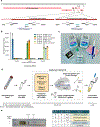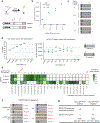CRISPR-Cas12-based detection of SARS-CoV-2
- PMID: 32300245
- PMCID: PMC9107629
- DOI: 10.1038/s41587-020-0513-4
CRISPR-Cas12-based detection of SARS-CoV-2
Abstract
An outbreak of betacoronavirus severe acute respiratory syndrome (SARS)-CoV-2 began in Wuhan, China in December 2019. COVID-19, the disease associated with SARS-CoV-2 infection, rapidly spread to produce a global pandemic. We report development of a rapid (<40 min), easy-to-implement and accurate CRISPR-Cas12-based lateral flow assay for detection of SARS-CoV-2 from respiratory swab RNA extracts. We validated our method using contrived reference samples and clinical samples from patients in the United States, including 36 patients with COVID-19 infection and 42 patients with other viral respiratory infections. Our CRISPR-based DETECTR assay provides a visual and faster alternative to the US Centers for Disease Control and Prevention SARS-CoV-2 real-time RT-PCR assay, with 95% positive predictive agreement and 100% negative predictive agreement.
Conflict of interest statement
COMPETING INTERESTS
CYC is the director of the UCSF-Abbott Viral Diagnostics and Discovery Center (VDDC), receives research support funding from Abbott Laboratories, and is on the Scientific Advisory Board of Mammoth Biosciences, Inc. JSC is a co-founder of Mammoth Biosciences, Inc. JPB, CLF, JS and XM are employees of Mammoth Biosciences, Inc. CYC, JPB, XD, CLF, JS, XM and JSC are co-inventors of CRISPR-related technologies.
Figures


Similar articles
-
iSCAN: An RT-LAMP-coupled CRISPR-Cas12 module for rapid, sensitive detection of SARS-CoV-2.Virus Res. 2020 Oct 15;288:198129. doi: 10.1016/j.virusres.2020.198129. Epub 2020 Aug 18. Virus Res. 2020. PMID: 32822689 Free PMC article.
-
Ultrasensitive and visual detection of SARS-CoV-2 using all-in-one dual CRISPR-Cas12a assay.Nat Commun. 2020 Sep 18;11(1):4711. doi: 10.1038/s41467-020-18575-6. Nat Commun. 2020. PMID: 32948757 Free PMC article.
-
A reverse-transcription recombinase-aided amplification assay for the rapid detection of N gene of severe acute respiratory syndrome coronavirus 2(SARS-CoV-2).Virology. 2020 Oct;549:1-4. doi: 10.1016/j.virol.2020.07.006. Epub 2020 Jul 29. Virology. 2020. PMID: 32758712 Free PMC article.
-
Recent progress on the diagnosis of 2019 Novel Coronavirus.Transbound Emerg Dis. 2020 Jul;67(4):1485-1491. doi: 10.1111/tbed.13620. Epub 2020 May 31. Transbound Emerg Dis. 2020. PMID: 32395897 Free PMC article. Review.
-
Detection of COVID-19: A review of the current literature and future perspectives.Biosens Bioelectron. 2020 Oct 15;166:112455. doi: 10.1016/j.bios.2020.112455. Epub 2020 Jul 21. Biosens Bioelectron. 2020. PMID: 32739797 Free PMC article. Review.
Cited by
-
Insight into the natural regulatory mechanisms and clinical applications of the CRISPR-Cas system.Heliyon. 2024 Oct 18;10(20):e39538. doi: 10.1016/j.heliyon.2024.e39538. eCollection 2024 Oct 30. Heliyon. 2024. PMID: 39502233 Free PMC article. Review.
-
Detection of SARS-CoV-2 RNA using RT-LAMP and molecular beacons.Genome Biol. 2021 Jun 3;22(1):169. doi: 10.1186/s13059-021-02387-y. Genome Biol. 2021. PMID: 34082799 Free PMC article.
-
CRISPR-Cas-based techniques for pathogen detection: Retrospect, recent advances, and future perspectives.J Adv Res. 2023 Aug;50:69-82. doi: 10.1016/j.jare.2022.10.011. Epub 2022 Oct 30. J Adv Res. 2023. PMID: 36367481 Free PMC article. Review.
-
RNA-Responsive gRNAs for Controlling CRISPR Activity: Current Advances, Future Directions, and Potential Applications.CRISPR J. 2022 Oct;5(5):642-659. doi: 10.1089/crispr.2022.0052. Epub 2022 Oct 7. CRISPR J. 2022. PMID: 36206027 Free PMC article. Review.
-
Development of a rapid and sensitive quantum dot nanobead-based double-antigen sandwich lateral flow immunoassay and its clinical performance for the detection of SARS-CoV-2 total antibodies.Sens Actuators B Chem. 2021 Sep 15;343:130139. doi: 10.1016/j.snb.2021.130139. Epub 2021 May 21. Sens Actuators B Chem. 2021. PMID: 34035562 Free PMC article.
References
-
- World Health Organization. Coronavirus disease 2019 (COVID-19) Situation Report - 44 8 (World Health Organization, Geneva, Switzerland, 2020).
METHODS-ONLY REFERENCES
Publication types
MeSH terms
Substances
Grants and funding
- R21 AI129455/AI/NIAID NIH HHS/United States
- R33 AI120977/AI/NIAID NIH HHS/United States
- R33-AI129455/Division of Intramural Research, National Institute of Allergy and Infectious Diseases (Division of Intramural Research of the NIAID)/International
- R01-HL105704/U.S. Department of Health & Human Services | NIH | National Heart, Lung, and Blood Institute (NHLBI)/International
- R01 HL105704/HL/NHLBI NIH HHS/United States
LinkOut - more resources
Full Text Sources
Other Literature Sources
Medical
Miscellaneous

